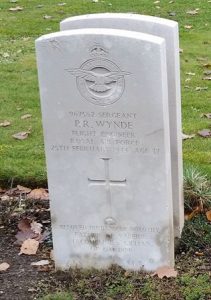Brecon is a market town in mid Wales and is the county town of the old historic county of Brecknockshire, or Breconshire. The town is the second largest in the county, after Ystradgynlais, and the third largest in the modern county of Powys, which it now lies within. The town of Brecon is synonymous with the famous army regiment, the South Wales Borderers, and the old regimental depot houses the regimental museum, which now incorporates the Welch Regiment and Royal Welch Fusiliers. As a result, many of the young men of Brecon served with the South Wales Borderers during both World Wars and earlier, even during the later post war conflict in Aden. The men of Brecon who died during the Great War of 1914-1918 are commemorated on the town war memorial, which is situated within the grounds of St. Mary’s Church. Additional names were added to the memorial following the end of World War Two, to commemorate the towns fallen from the latter war also.
This page commemorates the men of Brecon who fell during World War Two. There are several men and women whose names are omitted from the memorial, so I have taken the opportunity to add these details below. Included among these are a number of Indian troops of the Mule Corps who died whilst stationed in the area and are buried in Brecon.
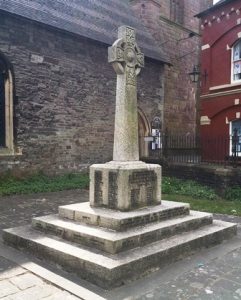
World War Two, 1939-1945
Muhammad Ali, Driver, 181389, Royal Indian Army Service Corps. Muhammad was the son of Abdulla and Phani; and was the husband of Noor Bibi, of Satnour, Hoshiarpur, India. He enlisted into the Royal Indian Army Service Corps and was posted to Britain with the 7th Mule Company. Muhammad probably served in France with the BEF at the outbreak of war and would then have been evacuated from Dunkirk. He died at Brecon on 10 June 1942, aged 22, and is buried in Brecon Cemetery. He is not commemorated on the Brecon war memorial.
Aurangzeb, Bellows Boy, 181367, Royal Indian Army Service Corps. Aurangzeb was the son of Muhammad Khalil, and Gulab Bano, of Rojoa, Rawalpindi. He enlisted into the Royal Indian Army Service Corps and was posted to Britain with the 3rd Mule Company. Aurangzeb probably served in France with the BEF at the outbreak of war and would then have been evacuated from Dunkirk. He died at Brecon on 13 March 1942, aged 18, and is buried in Brecon Cemetery. He is not commemorated on the Brecon war memorial.
William John Bagley, Sergeant, 1315216, Royal Air Force Volunteer Reserve. William was born in 1923, the son of Police Constable Oliver John Bagley and Florence Mary Bagley (nee Hargest), of Brecon Police Station. His parents had moved to Llanfihangel Talyllyn prior to the war, whilst William left home to enlist into the Royal Air Force Volunteer Reserve. William was already an experienced pilot when he was posted to 103 Conversion Flight at RAF Elsham Wolds, in Lincolnshire, to train on the Handley Page Halifax III heavy bomber. On 1 August 1942 he took off from Elsham Wolds flying Halifax III, Serial R9379 on a general handling training flight. The aircraft suffered an engine failure whilst circling the airfield and crashed into the ground and exploded, killing William and all the airmen aboard. The remains of the 19-year-old were recovered from the wreck, and he was brought home for burial in St. David’s Churchyard, Brecon. William is not commemorated on the Brecon war memorial.
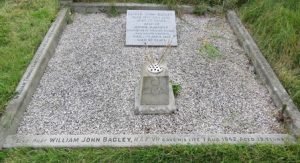
Ali Bahadur, Driver, 783729, Royal Indian Army Service Corps. Ali was the son of Bostan Muhammad, and Fatama Bibi, of Ardala Isman Zada, Rawalpindi. He enlisted into the Royal Indian Army Service Corps and was posted to Britain with the 3rd Mule Company. Ali probably served in France with the BEF at the outbreak of war and would then have been evacuated from Dunkirk. He died at Brecon on 12 October 1941, aged 21, and is buried in Brecon Cemetery. He is not commemorated on the Brecon war memorial.
Stanley Claude Blake, Serjeant, 3909536, South Wales Borderers. Stanley was born at Pontypool in 1920, the son of Edwin George Blake and Elizabeth Blake (nee Gough). He married Annie O’Shea, of Brecon, in 1941. Stanley enlisted at Brecon into the army and was posted to the 2nd Battalion, South Wales Borderers. The battalion was a regular army unit and was in Northern Ireland at the outbreak of war. In December 1939 the battalion left Northern Ireland and joined the 148th Infantry Brigade, 49th (West Riding) Infantry Division, then in April 1940 transferred to the 24th Guards Brigade (Rupertforce), before landing in Norway to take part in the Norwegian Campaign. The battalion was among the first British troops to see action against the Germans during the war. The Norway campaign ultimately failed, and the brigade was evacuated back to Britain. The 2nd SWB then transferred to the 37th Independent Infantry Brigade, which was redesignated as the 7th Infantry Brigade the following day and remained with the brigade until 1 March 1944 when it transferred to the newly created 56th Independent Infantry Brigade, together with the 2nd Essex and the 2nd Gloucester’s, before beginning training for the invasion of Normandy. The battalion became the only Welsh battalion to take part in the Normandy landings on 6 June 1944, landing at Gold Beach under command of the 50th (Northumbrian) Infantry Division. Stanley was killed near Caen on 8 July 1944. The 24-year-old was originally buried in La Croix des Landes, but his grave was later exhumed, and he was re-interred in Bayeux War Cemetery, France on 5 August 1945. His widow, Annie, also lost her brother-in-law, George Henry Cracknell, during the war.
Charles Powell Bomford, Flying Officer, 37712, Royal Air Force. Charles was born in Ireland on 5 May 1915, the son of Captain Charles Francis Bomford and Dorothy Maud Bomford (nee Price), of Ballycommon, Co. Tipperary, Irish Republic. His mother was from Brecon, the daughter of Reverend John Price, and his father was a long serving officer in the Leinster Regiment who had married just prior to the outbreak of war. Upon leaving school, Charles enlisted into the Royal Air Force and trained as a pilot. He was posted to 107 Squadron, RAF soon after the outbreak of war. The squadron was based at RAF Wattisham and flew missions over France during the withdrawal of the BEF from Dunkirk in May 1940. On 9 June 1940 Charles took off from Wattisham flying a Bristol Blenheim IV, Serial L9323 on a raid against a German armoured unit situated in the Foret de Bray. The Blenheim was hit by German flak and crashed near Torcy-Le-Petit, near Dieppe whilst en-route, killing Charles and his observer, Sergeant Bowman. Charles was 25 years old when he was killed that day and is buried beside Bowman in Torcy-le-Petit Communal Cemetery, France. His brother, Richard, was killed in Italy in 1944. Neither man is commemorated on the Brecon war memorial.
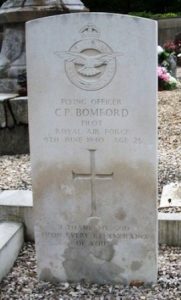
Richard Lyndon Bomford, Lieutenant, 256116, Rifle Brigade. Richard was born in Ireland on 3 April 1922, the son of Captain Charles Francis Bomford and Dorothy Maud Bomford (nee Price), of Ballycommon, Co. Tipperary, Irish Republic. His mother was from Brecon, the daughter of Reverend John Price, and his father was a long serving officer in the Leinster Regiment who had married just prior to the outbreak of war. Richard was commissioned as Second Lieutenant into the Rifle Brigade in February 1943 and was posted to the 10th (2nd Bn. The Tower Hamlets Rifles) Battalion. Richard then embarked for North Africa to join the battalion, which was in the Libyan desert, attached to the 26th Armoured Brigade, 6th Armoured Division. Richard would have joined the battalion after it had taken part in the Battle of the Kasserine Pass, where the 6th Armoured Division had been forced into action to support the beleaguered Americans. The division then refitted and re-equipped with the M4 Sherman tank before taking part in the final actions in North Africa soon afterwards. The division was then assigned to the US Fifth Army, under General Mark Clark, and took part in the invasion of Italy. Richard was killed in Italy on 29 May 1944. The 21-year-old is buried in Cassino War Cemetery, Italy. His brother, Charles, was killed in 1940. Neither man is commemorated on the Brecon war memorial.
Jack Capper, Signalman, 2342708, Royal Corps of Signals. Jack was born on 12 September 1915, the son of Albert Capper and Emma Capper (nee Davies), of 34, High Street, Brecon. Upon leaving Brecon Grammar School he became a schoolteacher and by 1939 was lodging at 89, Stanhope Road, Northampton. Jack enlisted into the Royal Corps of Signals soon after the outbreak of war and was posted to the Far East to join the 11th Indian Division Signals. The division was holding the front line in Malaya, near Jitra, when the Japanese invaded Thailand on 8 December 1941 and was still at work on its defensive systems when the Japanese struck two days later, and the division suffered terrible casualties during the ensuing Battle of Jitra. The survivors withdrew to Singapore, but when Singapore fell on 15 February 1942 were taken into captivity by the brutal Japanese. Jack was posted as missing, believed killed, in Singapore on 12 February 1942, just prior to the surrender. No trace of the 26-year-old was ever found, so he is commemorated on the Singapore Memorial.
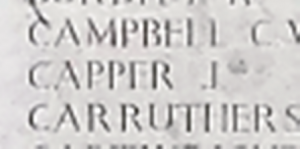
George Henry Cracknell, Sailor, Merchant Navy. George was born in Hull on 25 April 1909, the son of George Henry Cracknell and Matilda Cracknell (nee Hepworth). His father was killed at Arras on 27 June 1917. George worked as a labourer at Hull prior to enlisting into the Royal Navy on 25 April 1927 and was posted to HMS Impregnable at Plymouth for training. He then had several postings, aboard HMS Emperor of India; HMS Dragon; and HMS Delhi before being posted to HMS Pembroke I in December 1928. George then had several more postings before leaving the Royal Navy in August 1931, with a chequered service history, which included several offences. By 1939 he had moved to 30, High Street, Brecon, where he married Gladys Olwen O’Shea, the daughter of a long serving soldier, Sergeant James O’Shea, of the South Wales Borderers. George enlisted into the Merchant Navy soon after the outbreak of war and was posted aboard the London registered cargo steamer SS Bibury. On 23 August 1940, Bibury left Cardiff with a cargo of almost 7,500 tons of coal, bound for Buenos Aires. The steamer joined Convoy OB-205 at Milford Haven for the hazardous voyage across the Atlantic. During the early hours of 31 August 1940, Bibury was steaming together with two other freighters, dispersed from the convoy, when she was struck by two torpedoes which had been fired from the lurking German submarine U-59 and sank within five minutes with the loss of 39 lives. George was 31 years old when he died as a result of the attack. He has no known grave but the sea, so he is commemorated on the Tower Hill Memorial, London. His widow, Gladys, also lost her brother-in-law, Stanley Claude Blake, during the war.
Frederick Verdun Dacey, Sergeant (Air Gunner), 1325318, Royal Air Force Volunteer Reserve. Frederick was born on 12 April 1916, the son of David Dacey and Alma Dacey (nee Pryce), of 10, Maendu Street, Brecon. His father was killed in France in 1918. The family moved to Leicester after the war and Frederick found work there as a clerk. Frederick enlisted into the Royal Air Force Volunteer Reserve soon after the outbreak of war and after training as an Air Gunner was posted to 50 Squadron, RAF, which was based at RAF Swinderby, in Lincolnshire. During the evening of 12 October 1942, Frederick took off from neighbouring RAF Syerston aboard an Avro Lancaster I, Serial R5902, which was part of a large group of bombers despatched to hit targets in Wismar. Frederick’s Lancaster was flying off the German Baltic coast when it was hit by flak and crashed in Lubeck Bay, killing six of her crew of seven men. Frederick was 25 years old when he was killed during the crash that night. He has no known grave and is commemorated on the Runnymede Memorial, Surrey, England. Frederick is not commemorated on the Brecon War Memorial.
Keith David, Private, 4081421, The Queen’s Royal Regiment (West Surrey). Keith was born in Brecon in 1922, the son of Elizabeth David. He enlisted into the South Wales Borderers under the alias of Keith David Mullen soon after the outbreak of war, but on 8 January 1942 he transferred to the 2/6th Battalion, The Queen’s Royal Regiment (West Surrey). Soon afterwards Keith married Dilys Eleanor Elizabeth Harris, of Brecon. Keith’s battalion was attached to the 169th Infantry Brigade, 56th Division and in August 1942 embarked at Liverpool for Iraq for training and for garrison duties. Some six months later the division was transferred to North Africa, but with the campaign now almost at a close, the division spent the coming months in Libya on garrison duties. The 56th Division left Libya on 4 September and landed at Salerno on 9 September 1943, to take part in the campaign to drive the occupying Germans out of Italy, which had surrendered. Keith would have then taken part in the bloody battles for Salerno and Anzio, before the Allies began the slow drive northwards through Italy, fighting for every yard. Keith was killed during the attempt to capture Gemmano Ridge on 29 January 1944. The 22-year-old is buried in Minturno War Cemetery, Italy. Keith is not commemorated on the Brecon war memorial.
Kenneth Roger Davies, Private, 14270864, Queen’s Own Royal West Kent Regiment. Kenneth was born in 1924, the son of Hugh Powell Davies, and of Hilda Davies (nee Rees), of Llanfaes, Brecon. He enlisted into the army as soon as he turned 18 and was posted out to the Far East to join the 4th Battalion, Queen’s Own Royal West Kent Regiment. The Battalion was a Territorial Army unit, which was attached to the 132nd Infantry Brigade, 44th (Home Counties) Division and had served in France with the BEF in 1940. After two years back in Britain the division embarked for North Africa, then early in 1943 the 4th Queen’s Own Royal West Kent Regiment was transferred to Burma to join the 161st Indian Infantry Brigade, 5th Indian Division. The battalion then became involved in the infamous Battle of Kohima, a long and bloody affair, where it played a major role in the Battle of the Tennis Court, which saw one man of the battalion, Lance Corporal John Harman, posthumously awarded the Victoria Cross. The battalion held out here for several days, under overwhelming pressure, with the Japanese launching a series of suicidal attacks upon the battalions positions. Kenneth was probably wounded during heavy fighting on 13 April as he died on 14 April 1944, after the Japanese had been forced to give up. The 20-year-old has no known grave and is commemorated on the Rangoon Memorial, Myanmar.
Vernon David Davies, Private, 4081487, South Wales Borderers. Vernon was born on 3 June 1915, the son of Charles Davies and Margaret Davies (nee Jones), of Brecon. His father, Charles Davies, died in India whilst serving with the Brecknocks in 1916. His mother married Alfred Samuel Letton, a carpenter, in 1920 and he brought Vernon up as his own son, training him as a carpenter. Vernon married Margery Evans at Brecon in 1940, after having enlisted into the South Wales Borderers and the couple set up home at Rhymney. Vernon must have taken ill whilst on active service, as he was home at Rhymney when he died on 4 July 1942. The remains of the 27-year-old were brought back home to Brecon, and he was buried in Brecon Cemetery.
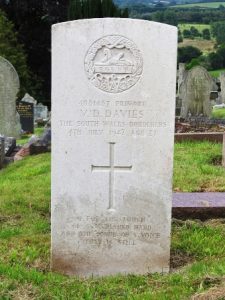
Muhammad Din, Driver, 65553, Royal Indian Army Service Corps. Muhammad was the son of Imam Din; and the husband of Ashan Bi, of Mori, Gujrat, India (now modern-day Pakistan). He enlisted into the Royal Indian Army Service Corps and was posted to Britain with the 7th Mule Company. Muhammad probably served in France with the BEF at the outbreak of war and would then have been evacuated from Dunkirk. He died at Brecon on 10 July 1942, aged 30, and is buried in Brecon Cemetery. He is not commemorated on the Brecon war memorial.
Sarah Eira Durham, Nurse. Sarah was born at Brecon on 30 January 1910, the daughter of James Durham, a soldier of the South Wales Borderers, and Jessie Durham (nee Griffiths), of Coach and Horses, Llanfaes, Brecon. Sarah trained as a physiotherapist at Swansea, before leaving Wales to work at the Park Hospital, Lewisham and then at St. Thomas’s Hospital, Lambeth. Sarah was working at St. Thomas’s when the hospital was hit by a bomb during an air raid on 9 September 1940, at the height of the London Blitz. A single bomb hit the nurses block, killing six young women. Further fatalities were to occur as the hospital was hit several more times over the coming days. Sarah was just 28 years old when she was killed that day, and she is commemorated in the Civilian Book of Remembrance at Westminster Cathedral. Sarah is not commemorated on the Brecon war memorial.
John Francis Evans, Fusilier, 4189981, Royal Welch Fusiliers. John was born in Chatham in 1910, the son of William Evans, a soldier of the South Wales Borderers, and Emma Louise Evans (nee Gillard). The family moved back to Brecon prior to the war and lived at 11, Charles Street, Brecon. John’s father, William, died of heart failure at Ypres whilst still stationed out there with the army in 1920 after having served throughout the conflict. John followed in his fathers’ footsteps and enlisted into the army as a young man, joining the 1st Battalion, Royal Welch Fusiliers. The battalion embarked for France with the BEF, and took up positions on the River Dyle at Ottenburg, north of Wavre, where the battalion first made contact with the attacking Germans on 14 May 1940. The forward company was subjected to intense mortar fire and a series of unsuccessful attacks throughout the following day. Meanwhile the Germans had broken through near Sedan, threatening the southern flank of the BEF, and orders for the Battalion to withdraw came on the night of 15-16 May. There was no transport available initially, so the men were forced to withdraw on foot, digging in at night in case of further attacks. Trucks arrived on 18 May and took the Battalion to Tournai on the Escaut where they held the river line under heavy fire for two days. Late on 20 May, with the German forces again threatening to outflank the BEF, the 1st RWF were told to withdraw to the area north of Béthune, where they arrived on 24 May, but the shattered battalion was then ordered to advance westward to capture four bridges over the La Bassée Canal, south of Saint-Venant. The first attack was carried out on the evening of 24 May and the battalion captured Saint-Floris but could not force their way into Saint-Venant. Fighting raged overnight and during the following days. John appears to have been taken prisoner of war at some time during this terrible period for the battalion and was incarcerated in Stalag 344, in Lambinowice, Poland. He was killed during an air raid on 11 April 1945, whilst still a POW. The 35-year-old has no known grave and is commemorated on the Dunkirk Memorial, France.
Evans, G? This person cannot presently be identified.
Thomas Cyril Fenn, DSM, MiD, Able Seaman, P/JX 130362, Royal Navy. Thomas was born on 17 July 1911, the son of David John Fenn and Annie Mabel Fenn (nee Shaw), of 12, Alexandra Road, Brecon. He worked as a grocer’s assistant prior to enlisting into the Royal Navy on 7 July 1929 and was posted to HMS Impregnable at Plymouth for training. Upon completing his training, Thomas was posted to HMS Vivid I, before seeing service aboard a number of ships prior to the war. Thomas had been awarded the Distinguished Service Medal for his services aboard HMS Faulknor in 1940, possibly for his actions during the sinking of the German submarine U-39 and was then posted aboard the Tribal-class destroyer, HMS Somali. She was refitted in the summer of 1941 and fitted with modern radar before moving to Scapa Flow to continue escort duties and was later assigned to the Arctic Convoys, or Murmansk run. In September 1942, while escorting convoy QP-14, the convoy was spotted by awaiting German U-Boats, which sunk two Merchant steamers. HMS Ashanti went off in pursuit of the submarines, but began to run low on oil, so moved back into position, before Somali took her place on the outer escort screen. During the evening of 20 September 1942, Somali was hit by a torpedo which had been fired by the submarine U-703 and lost power. Struggling to repair her holed hull in the dark, her crew abandoned her, leaving just a skeleton crew, and she was taken in tow by Ashanti. With no power it was impossible to pump the water out of the badly damaged destroyer and Somali sank in a squall on 25 September 1942. Thomas was posted as having been killed on 24 September 1942, so was probably among the salvage party aboard Somali when he died. The 31-year-old has no known grave and is commemorated on the Portsmouth Naval Memorial, Hampshire. Thomas was posthumously Mentioned in Despatches later that year.
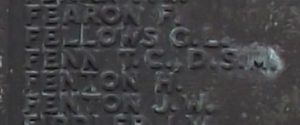
Douglas John Goodger, Petty Officer, P/SSX 20796, Royal Navy. Douglas was born on 14 October 1919, the son of Frederick John Goodger and Edith Mary Goodger (nee Edwards), of 13, Watergate Street, Brecon. His father, a former soldier with the South Wales Borderers, was a cook at Brecon Barracks. Douglas enlisted into the Royal Navy as a young man and at some time following the outbreak of war was posted aboard the F-class destroyer, HMS Faulknor, which was originally assigned to the Home Fleet at Scapa Flow. She took part in anti-submarine patrols together with the aircraft carrier Ark Royal, before sinking the German submarine U-39 following an unsuccessful attack on the carrier. She then began escort duties in the North Atlantic before taking part in the evacuation of Allied troops from Norway in May 1940. Faulknor suffered some damage when running aground in Norway but managed to get back to Grimsby for repairs before escorting HMS Hood and the aircraft carrier Ark Royal from Scapa Flow to Gibraltar where they would form Force H. Faulknor then participated in the Malta convoys before escorting Hood back into the North Atlantic, where the mighty battleship was sunk by the Bismarck. After participating in the hunt for the Bismarck, she then returned to the Mediterranean, before returning to Britain for a refit. She then returned to Scapa Flow and escorted the battleship HMS Duke of York as she ferried Prime Minister Winston Churchill to meet with President Roosevelt in the Atlantic Conference in mid-December. Returning to Scapa Flow, Faulknor then began escort work on the Arctic convoys to Murmansk. Douglas was lost overboard during heavy seas whilst escorting Convoy JW52 to Murmansk on 12 January 1943. The 23-year-old has no known grave and is commemorated on the Portsmouth Naval Memorial, Hampshire.
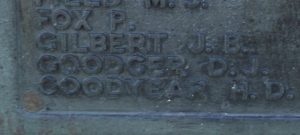
Muhammad Gul, Driver, 172264, Royal Indian Army Service Corps. Mohammad was the son of Ghulam Hussain and Rahmat Noor, of Banda Hazara. enlisted into the Royal Indian Army Service Corps and was posted to Britain with the 29th Mule Company. Gul probably served in France with the BEF at the outbreak of war and would then have been evacuated from Dunkirk. He died at Brecon on 29 May 1942, aged 29, and is buried in Brecon Cemetery. He is not commemorated on the Brecon war memorial.
William Roger Gwillim, Captain, 113481, South Wales Borderers. William was born in Brecon in 1913, the son of Walter Gwillim, a pharmacist, and Harriet Ada Gwillim (nee Brace). After leaving Christ College he trained as a chemist and married a fellow trainee chemist, Marion Wild, at Dorchester early in 1944. William had enlisted into the Honourable Artillery Company Officer Cadet Training Unit soon after the outbreak of war and was commissioned as Second Lieutenant into the South Wales Borderers on 14 January 1940. By the time of the D-Day landings, William had been posted to the 5th Battalion, Queen’s Own Cameron Highlanders, which was attached to the152nd Brigade, 51st (Highland) Division. The Division had been reformed following its decimation at Saint-Valery-en-Caux in June 1940, before embarking for North Africa and saw action at the Second Battle of El Alamein in October 1942. The Division then took part in the Allied invasion of Sicily in July 1943. The Division was recalled to Britain and took part in the Normandy landings in June 1944, fighting in the Battle for Caen in July and the Battle of the Falaise Gap in August before capturing Le Havre. Following the break-out from Normandy, the Division took part in the advance through Northern France into Belgium and Holland, before taking part in Operation Pheasant, the operation to clear the Germans from North Brabant. Gwillim was killed on 18 November 1944, during the advance to the Maas River which followed. The 31-year-old was originally buried in the 51st Highland Division burial ground Maaseik, Belgium, but after the war his grave was exhumed and he was re-interred in Mierlo War Cemetery, Netherlands.
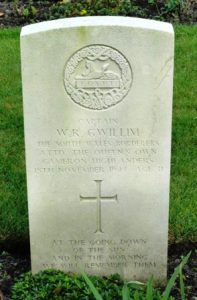
James Philip Vaughan Hargest, Sergeant, 1441087, Royal Air Force Volunteer Reserve. James was born on 6 September 1916, the son of James Hargest and Mary Jane Hargest (nee Vaughan), of 11, St. David’s Street, Llanfaes, Brecon. He trained as a nurse after leaving school and by 1939 was working at Barnsley Hall Mental Hospital. James enlisted into the Royal Air Force Volunteer Reserve soon after the outbreak of war and after completing his training as an Air Bomber was posted to 218 (Gold Coast) Squadron, RAF, which was based at RAF Downham Market. The squadron had flown in France supporting the BEF in May 1940, before being evacuated to England and re-equipping with the Bristol Blenheim. In November, it rearmed with Vickers Wellingtons, and began bombing targets further afield, before re-equipping with Short Stirling heavy bombers in December 1941. In July 1942, the unit moved to RAF Downham Market where it continued to mount bombing operations. James took off from Downham Market aboard Short Stirling III, Serial EF367 on the evening of 13 May 1943 as part of a force of some 442 aircraft sent to hit targets in Bochum, Germany. His Stirling was attacked by an enemy night fighter whilst over the target, suffering heavy damage, and the rear gunner was killed, so the bomb load was jettisoned, and the stricken aircraft made its return to base. Losing fuel from a punctured fuel tank, the Stirling made for RAF Chedburgh and began to prepare for a belly landing. Sadly, all four engines cut out during the approach and the Stirling crashed on the edge of the airfield, killing all bar two of the surviving crew. James was 26 years old when he died in the resulting crash. His remains were recovered from the wreck, and he was brought home for burial in St. David’s Churchyard, Brecon. His uncle, Phillip Hargest, had been killed during the Great War.
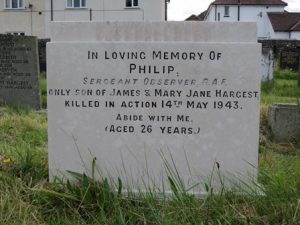
Eileen Margaret Hopkins, Leading Aircraftwoman, 2076304, Women’s Auxiliary Air Force. Eileen was born in 1923, the daughter of Frederick James Hopkins and Mary Edith Caroline Hopkins (nee Lewis), of 13, St. David Street, Llanfaes, Brecon. She enlisted into the Women’s Auxiliary Air Force and was posted to 32 Maintenance Unit at RAF St. Athan, in Glamorgan. The site had opened on 1 September 1938 to become the home of No. 4 School of Technical Training, then gradually expanded with the arrival of a fighter group, the School of Air Navigation, and a maintenance unit. Eileen’s unit, 32 MU, specialised in installing top secret electronic devices. Eileen had not been at St. Athan long when she took ill and died in hospital at the base on 15 December 1943. The remains of the 20-year-old were brought home and she was buried in St. David’s Churchyard, Brecon. Eileen is not commemorated on the Brecon war memorial.
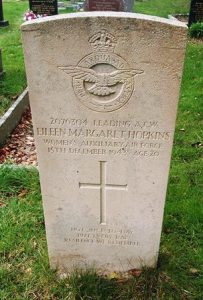
Ernest James Emrys Jarman, Sergeant, 1419269, Royal Air Force Volunteer Reserve. Ernest was born in 1922, the son of James Jones Jarman and Mary Hannah Jarman (nee Cook), of Watton, Brecon. His mother died when he was just seven years old, and his father remarried Elizabeth Margaret Wilding. Ernest enlisted into the Royal Air Force Volunteer Reserve soon after the outbreak of war and after training as an Air Bomber was posted to 10 Squadron, Royal Air Force, which was based at RAF Melbourne. On the night of 27 September 1943, Ernest took off from Melbourne aboard a Handley Page Halifax II, Serial JD272, which joined a large force of some 678 aircraft despatched to strike targets in Hanover. The crew was very young, with its average age being just 20 years old, but the young men were all experienced. The Halifax was brought down over Germany that night, with the loss of all seven of its crew. Ernest was just 21 years old when he died that night. He was originally buried in Wippingen Catholic Cemetery alongside his fellow crewmen, but in May 1947 their graves were exhumed, and the men were re-interred in Reichswald Forest War Cemetery, Germany. Ernest is not commemorated on the Brecon war memorial.
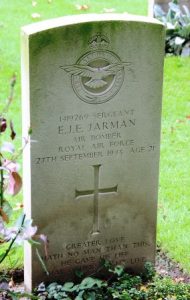
Glynn Jones, Private, 7254832, Royal Army Medical Corps. Glynn was born in Brecon in 1918 and was probably educated at Christ College. He enlisted into the Royal Army Medical Corps soon after the outbreak of war and was posted to the 9th Field Ambulance, RAMC, which was attached to the 3rd Infantry Division. The division embarked for France with the BEF under the command of Major General Bernard Law Montgomery in September 1939. The division saw no real action until May 1940 when the Germans launched their Blitzkrieg attack onto the Low Countries and took part in the slow withdrawal towards Dunkirk. Glynn was killed near Dunkirk, possibly during the evacuation itself, on 1 June 1940. The 21-year-old has no known grave and is commemorated on the Dunkirk Memorial, France.
James Howell Jones, Lance Corporal, 2589516, Royal Corps of Signals. James was the son of Joseph Jones and Rachael Jones (nee Williams), of Newchurch, Carmarthenshire. He married Mabel Morris, of Brecon, in 1939. James enlisted into the army and was posted to the Royal Corps of Signals. He served with the 53rd (Welsh) Divisional Signal Company, which had landed in Normandy towards the end of June 1944 and had fought through France and Belgium into Holland and Germany during the coming months. James died while in Germany as part of the British Army on the Rhine on 20 December 1945. He was 28 years old, and is buried in Cologne Southern Cemetery, Germany. James is not commemorated on the Brecon war memorial, but is commemorated at Newchurch, near Carmarthen.
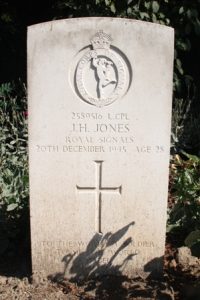
Sidney Ernest Benjamin Lee, Captain, 126148, South Wales Borderers. Sidney was born in 1911, the son of Sidney Martin Lee and Alice Maude Lee (nee Meehan), of Bedwellty. He married Florence Doreen Parry, of Brecon in 1939 and the couple set up home at 2a John Street, Brecon. Sidney enlisted into the 162nd Officer Cadet Training Unit soon after the outbreak of war and on 16 March 1940 was commissioned as Second Lieutenant into the South Wales Borderers. He was subsequently attached to the 4th Battalion, Welch Regiment, which was a Territorial unit, based in Carmarthenshire, and attached to the 53rd (Welsh) Division. The battalion was mobilised at the outbreak of war, when the Division moved to Northern Ireland to begin garrison duties. The Division then moved to Pembroke Dock, before moving again to the south of England, where it trained in readiness for the D-Day Landings. On 24 June 1944 the division left England for Normandy, and landed at La Riviere near Ver Sur Mer. The Division then took part in heavy fighting over the coming weeks, as part of the effort to break-out of the Normandy beachhead, seeing heavy fighting at Évrecy, before starting the epic advance through Northern France into Belgium and Holland. On 15 September the Division forced the crossing of the Junction Canal North of Lommel, and continued to push westwards towards Elst, between Nijmegen and Arnhem, during Operation Market Garden. On the evening of 25 September, the 4th Welch went into action to assist the 6th RWF in clearing the town of Reusel. Their objectives were swiftly attained, and the battalion dug in for the night. On the following morning the Germans counter-attacked and heavy fighting ensued. Sidney was killed in action during the day, 26 September 1944. The 33-year-old is buried in Valkenswaard War Cemetery, Netherlands. His brother, Harold George Lee, died on active service the following year.
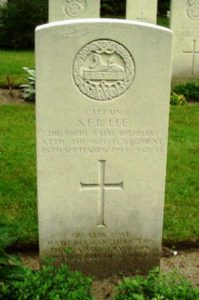
Ezra Brinley Lewis, Private, 4081083, Monmouthshire Regiment. Ezra was born on 22 August 1915, the son of Ezra William Lewis and Annie Lewis (nee Rees), of 70, The Struet, Brecon. His father died in 1921. Ezra worked as a clerk for a local ironmonger prior to the war. He enlisted into the army and was posted to the 3rd Battalion, Monmouthshire Regiment. The battalion, a Territorial Army unit, was mobilised for war as part of the 53rd (Welsh) Division and moved to Northern Ireland to begin garrison duties. The Division then moved to Pembroke Dock, before moving again to the south of England, where it trained in readiness for the D-Day Landings. In the summer of 1942, the 3rd Monmouth’s transferred to the 11th Armoured Division and began training as a mechanised unit, equipped with Valentine and Crusader tanks. Most of the 11th Armoured Division landed on Juno Beach on 13 June 1944 and saw its first major action during Operation Epsom on 26 June, where it assisted the 15th (Scottish) Division alongside the 159th Brigade, which had been attached to it from the 53rd (Welsh) Division. Ezra was killed in Normandy on 2 July 1944, probably during a German counterattack near the village of Mouen. The 28-year-old was originally buried near Mondrainville, but in February 1946 his grave was exhumed, and he was re-interred in Banneville-La-Campagne War Cemetery, France.
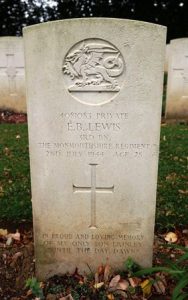
George Frederick Lewis, Corporal, 4077557, Durham Light Infantry. George was born on 8 November 1919, the son of George and Edith Lewis, of 14, St. David’s Street, Llanfaes, Brecon. He enlisted into the army and was posted to the 6th Battalion, Durham Light Infantry. The battalion, a Territorial Army unit, was attached to 151st Brigade, 50th (Northumbrian) Infantry Division, and had fought in France with the BEF in 1940 before being evacuated from Dunkirk. In April 1941 the division was sent to the Middle East, where it fought with distinction throughout the campaigns in the Western Desert. Following the surrender of the Afrika Korps, the division took part in Operation Husky, the invasion of Sicily, in July 1943, then in October was withdrawn from Sicily, returning to England to prepare for D-Day, coming under the command of XXX Corps. The 50th Division landed on Gold Beach as part of the second wave, in company with the 8th Armoured Brigade, and began to push inland, the 151st Brigade reaching the outskirts of Bayeux. Over the coming days the brigade advanced past Bayeux and on 14 June took part in a bloody action against the Panzer Lehr Division. George was killed in Normandy on 1 July 1944. The 25-year-old was originally buried on the battlefield near Tilly, but in July 1945 the burials in the area were exhumed and re-interred in Tilly-sur-Seulles War Cemetery, France. George is not commemorated on the Brecon war memorial.
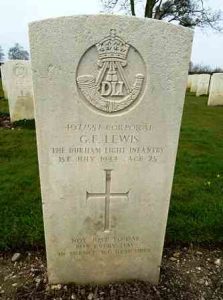
Rendel Forrest Lewis, MA, LLB, Flight Sergeant, 129118, Royal Air Force Volunteer Reserve. Rendel was born at Liverpool on 18 July 1915, the son of the Reverend John Daniel Vernon Lewis and Amelia Mary Lewis (nee Griffiths). His father was from Swansea and his mother from Llandeilo, Carmarthenshire. Rendel was educated at Llandovery, he trained as a Solicitor, finally becoming a Barrister of law. By 1939 he was residing with his parents at Nyddfa Lodge, Brecon, and his father was a Professor of Theology at Christ College. At the outbreak of war Rendel joined the Royal Air Force Volunteer Reserve, becoming an Instructor in Navigation at the RAF College Cranwell. Rendel volunteered for active service, and was posted to 630 Squadron, a Main Force Squadron in 5 Group, equipped with the Lancaster Bomber. On 8 December 1944, 205 bombers of 5 Group left Britain, on a mission to bomb the Urft Dam in Germany. Rendel was flying aboard an Avro Lancaster III, Serial LM637. The bombing was affected by the heavy cloud cover and was unsuccessful, but during a second gallant attempt to find the target, Rendel’s Lancaster collided with another Lancaster and crashed into the Schwammenauel, killing Rendel and four other crewmen. Rendel was 29 years old when he was killed that day. The wreck of the Lancaster was discovered during work in 1958 and Rendel was buried in Rheinberg War Cemetery, Germany. Rendel is not commemorated on the Brecon war memorial.
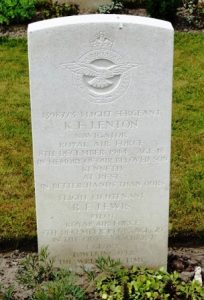
Albert Edward Anderson Matthews, DFC, Flight Lieutenant, 156039, Royal Air Force Volunteer Reserve. Albert was born on 8 August 1913, the son of Albert Edward Matthews and Gertrude Sarah Matthews (nee Anderson), of 1, Davies Terrace, Brynmawr. He was educated at Christ College before running his own grocery at Brecon and married Edith Mary Prosser at Brecon in 1937. Albert enlisted into the Royal Air Force Volunteer Reserve soon after the outbreak of war and after training as a Flight Engineer was posted to 49 Squadron, Royal Air Force, which was an RAF Bomber Command unit, based at RAF Fiskerton, in Lincolnshire. On 21 June 1944 Albert took off from Fiskerton aboard Avro Lancaster I, Serial LL900, as part of a large force of 130 bombers despatched to hit the synthetic oil plant at Wesseling. Aboard the aircraft was the BBC War Correspondent, Kent Stephenson. Albert and the crew were all killed when the Lancaster was intercepted and shot down by a German night fighter on the following morning, 22 June 1944. All of the crew of seven, and the BBC correspondent, were originally buried in Welldorff Cemetery, Germany, but in June 1947 their graves were exhumed, and the men were buried together in Rheinberg War Cemetery, Germany. Albert had been awarded the Distinguished Flying Cross during the war.
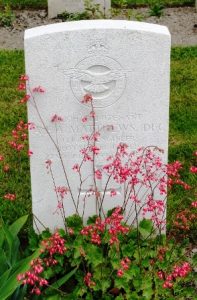
Arthur Henry Matthews, Fusilier, 14421145, Royal Welch Fusiliers. Arthur was born on 22 May 1925, the son of Owen Thomas Matthews and Gwendoline Matthews (nee Williams), of 14, Silver Street, Brecon. He enlisted into the army after his eighteenth birthday and was posted to the 7th Battalion, Royal Welch Fusiliers, which was attached to 158 Brigade, 53rd (Welsh) Division. The battalion was mobilised at the outbreak of war, when the Division moved to Northern Ireland to begin garrison duties. The Division then moved to Pembroke Dock, before moving again to the south of England, where it trained in readiness for the D-Day Landings. On 24 June 1944 the 7th RWF left England for Normandy, and landed at La Riviere near Ver Sur Mer. The Division then took part in heavy fighting over the coming weeks, as part of the effort to break-out of the Normandy beachhead, seeing heavy fighting at Évrecy, before starting the epic advance through Northern France into Belgium and Holland. On 15 September the Division forced the crossing of the Junction Canal North of Lommel, and continued to push westwards towards Elst, between Nijmegen and Arnhem, during Operation Market Garden. On 22 October the Division launched its famous assault on ‘s-Hertogenbosch, before continuing its advance to the German frontier. Between December 1944 and January 1945, the Division took part in the Battle of the Bulge, helping in the counterattack which helped save the Americans, who were under heavy pressure. Subsequent operations then centred around relieving American troops on the Meuse, and at the apex of the bulge, to release them for offensive operations against the flanks of the enemy salient. The 53rd (Welsh) Division took up positions on the left sector from Aye to Hotton and on 5 January 1945 the 7th RWF launched an assault against Waharday. The advance was held up by minefields and the muddy ground, so no gains were made. Arthur was killed in action during that day, 5 January 1945. The 19-year-old was originally buried in a temporary battlefield cemetery used by the 53rd Division, but in April 1947 the burials in the cemetery were exhumed and Arthur was re-interred in Hotton War Cemetery, Belgium.
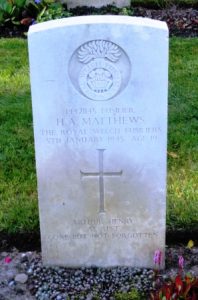
Ian Leslie Thomas Miller, MiD, Sub-Lieutenant (A), Royal Naval Volunteer Reserve. Ian was born in India on 1 May 1924, the son of Lieutenant Colonel William Kinchella Miller, South Wales Borderers, and Constance Isabel Miller (nee Thomas). On 1 March 1928 the family arrived back in England, after sailing from Bombay, and took up residence at Llandrindod Wells. Ian was educated at Christ College before enlisting into the Royal Naval Volunteer Reserve in 1940 and became a pilot with the Fleet Air Arm. By the end of 1944 was serving aboard the aircraft carrier HMS Nairana. On 20 October 1944, Nairana sailed with Russian convoy JW 61, as part of a large escort force, which was protecting 62 merchant ships. Aboard Nairana was 835 Naval Air Squadron with 14 Swordfish IIIs and six Wildcat VIs on board for what would be their first Arctic convoy. The strength of the convoy led to it entering the Kola Inlet at Murmansk unmolested. Ian was killed on the return leg of the voyage, probably during the loss of one of 835 Squadron’s Swordfish, on 12 December 1944, aged 20. He has no known grave and is commemorated on the Lee-on-Solent Memorial, Hampshire.
Ali Meharban, Naik, 29879, Royal Indian Army Service Corps. Ali was the son of Ghulam Haidet and Chano Bibi, of Dherian, Rawalpindi. He enlisted into the Royal Indian Army Service Corps and was posted to Britain with the 32nd Mule Company. Ali probably served in France with the BEF at the outbreak of war and would then have been evacuated from Dunkirk. He died at Brecon on 1 April 1941, aged 31, and is buried in Brecon Cemetery. He is not commemorated on the Brecon war memorial.
Hubert Arthur Moore, Private, 3908205, Army Catering Corps. Hubert was born at Talgarth on 7 May 1912, the son of Sarah Ann Moore. His baptism records state that his father was a carpenter, William Moore, of Bell Street, Talgarth, but William was her own father and Hubert’s real father was possibly a soldier, Arthur Samuel Bedford. His mother died in 1915 and Hubert then appears to have gone to live with his father’s new wife at Hay. Hubert married Agnes Bevan at Brecon in 1940. He had probably already enlisted into the army and served with the Army Catering Corps. Hubert was then attached to the 3rd Battalion, Monmouthshire Regiment. The battalion, a Territorial Army unit, was mobilised for war as part of the 53rd (Welsh) Division and moved to Northern Ireland to begin garrison duties. The Division then moved to Pembroke Dock, before moving again to the south of England, where it trained in readiness for the D-Day Landings. In the summer of 1942, the 3rd Monmouth’s transferred to the 11th Armoured Division and began training as a mechanised unit, equipped with Valentine and Crusader tanks. Most of the 11th Armoured Division landed on Juno Beach on 13 June 1944 and saw its first major action during Operation Epsom on 26 June, where it assisted the 15th (Scottish) Division alongside the 159th Brigade, which had been attached to it from the 53rd (Welsh) Division. Hubert would have worked hard under terrible conditions to help feed the fighting troops who were attempting to break out of the beachhead. He was killed in Normandy on 30 June 1944. The 32-year-old was originally buried in Mondrainville, but in February 1946 the graves in the area were exhumed and Hubert was re-interred in Banneville-La-Campagne War Cemetery, France. Hubert is not commemorated on the Brecon war memorial.
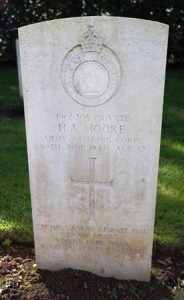
Ieuan Glynne Morgan, Sergeant, 1424536, Royal Air Force Volunteer Reserve. Ieuan was the son of Edgar Morgan and Margaret Jane Morgan (nee Morris), of Pencelly Court, Brecon. He enlisted into the Royal Air Force Volunteer Reserve soon after the outbreak of war and after training as a Wireless Operator/ Air Gunner was posted to No 15 Operational Training Unit at RAF Harwell. On the evening of 13 February 1944, Ieuan took off from Harwell aboard a Vickers Wellington X, Serial LN658, on a routine navigational exercise over the Irish Sea and Cardigan Bay. The planned route was to fly from base to Taunton, then to Bideford, onto St. Mary’s, then across the English Channel to Skomer Island, then over Fishguard and back via Worcester to base. At around 22.20 the aircraft went missing, possibly shot down into the Irish Sea by an enemy aircraft, or due to a mechanical failure, with the loss of all five men aboard. No trace of 22-year-old Ieuan or any of his fellow crewmen were ever found, so they are all commemorated on the Runnymede Memorial, Surrey. Ieuan is not commemorated on the Brecon war memorial.
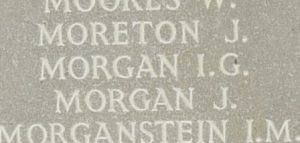
Albert Owen Morris, Private, 7590288, Royal Army Ordnance Corps. Albert was born in 1904, the son of James Morris and Mary Ann Morris, of Llanddew, Brecon. He married Edith Audrey Morris at Brecon in 1928 and the couple set up home at 12, Pendre, Brecon. Albert enlisted into the army soon after the outbreak of war and was posted to ‘Z’ Advanced Workshop, Royal Army Ordnance Corps, which was based at Maxwell Road, in Singapore. His wife, Edith, died in 1940, just before Albert had left Britain. The Japanese invaded Malaya and Thailand from Indochina on 8 December 1941 via an amphibious assault, in conjunction with their raid on the American base of Pearl Harbour, and swiftly forced Thailand to capitulate. This allowed the Japanese to concentrate their efforts on advancing into Malaya and Two days later, Force Z, consisting of the battleship HMS Prince of Wales, the battlecruiser HMS Repulse and several destroyers, was sunk by Japanese aircraft and the fortress of Singapore was soon under attack. January 1942 was a month of ferocious fighting for Singapore and many atrocities were carried out by the invading Japanese as, bit by bit, the garrison succumbed. Despite overwhelming superiority in troop numbers, Singapore was surrendered to the Japanese by Lieutenant-General Arthur Percival on 15 February 1941 and some 85,000 Allied troops were marched into captivity. Albert, together with his comrades of ‘Z’ Advanced Workshop were thought to have been evacuated on 13 February 1942, but many of his comrades were captured by the Japanese and taken to Palembang POW Camp, and several others were killed on that date, so it can only be assumed that Albert was killed by the Japanese at some time on or after that date. The 37-year-old has no known grave and is commemorated on the Singapore Memorial.
Garnet Wilfrid Morris, DFC, Flying Officer, 156771, Royal Air Force Volunteer Reserve. Garnet was born on 27 April 1916, the son of Garnett Morris and of Sarah Morris (nee Davies), of Manest Court, Llanhamlach, Brecon. He had a twin brother; Arden Gerald Morris and his father had served with the Brecknocks during the Great War. Garnet left home to join the Metropolitan Police and enlisted on 16 March 1936, being posted to M Division as a PC. He married Evelyn Mary Eastwood in 1940 and the couple briefly set up home together at 38, Rodenhurst Road, Clapham Park, London. Garnet left the Police to enlist into the Royal Air Force Volunteer Reserve and after training as a Navigator, was posted to 103 Squadron, Royal Air Force. The squadron had been in France supporting the BEF in 1940 and suffered severe losses before being evacuated and moved to RAF Abingdon. The Squadron was then transferred to RAF Newton near Nottingham, joining Bomber Command, and re-equipped with Vickers Wellington bombers before beginning raids on occupied Europe. The Squadron moved to RAF Elsham Wolds in July 1941, then in July 1942 re-equipped with Handley Page Halifax bombers, which were soon replaced by Avro Lancaster’s. Garnet was detached to No. 5 Operational Training Unit, Royal Canadian Air Force at some time after this and joined the unit in Abbotsford, British Columbia. On 3 July 1945 Garnet took off from Abbotsford aboard a Consolidated Liberator BVI, Serial KG880 on a routine night exercise. There appears to have been a mix-up and the aircraft went onto the wrong runway, where it collided with another Liberator at high speed, and Garnet was killed in the collision. He was posthumously awarded the Distinguished Flying Cross, the award being published in the London Gazette of 20 July 1945, for his service with 103 Squadron. The 29-year-old was buried in Hazelwood Cemetery, Abbotsford, Canada. Garnet is not commemorated on the Brecon war memorial.
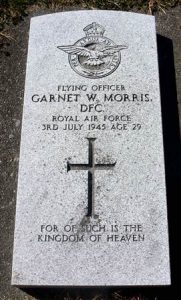
James Niblett, Chief Stoker, D/X 61908, Royal Navy. James was born near Weobley, Herefordshire on 18 April 1904, the son of Leonard Niblett and Mary Ann Niblett (nee Pritchard). James worked as a labourer prior to enlisting into the Royal Navy on 15 August 1923 and was posted to HMS Vivid II for training. He received his first posting aboard HMS Resolution and spent two years aboard here before returning to HMS Vivid II. James married Edith Ellen Hammond at Kington in 1928 and the couple set up home at The Tredegar Club, The Struet, Brecon. James continued to serve in the Royal Navy after his marriage and had several postings in the years leading up to the war. He was posted aboard the freshly refitted D-class destroyer HMS Diamond just prior to the outbreak of war. The destroyer joined the Mediterranean Fleet at the end of 1939, but was then transferred to the South Atlantic Station, but within months she was assigned back to the Mediterranean to join the 10th Destroyer Flotilla. Diamond then undertook convoy escort duties, seeing much action during the Malta convoys. On the evening of 26 April 1941, Diamond was in the Argolic Gulf with a number of other ships, having been ordered to evacuate troops from Nauplia, in Greece, which was in the process of falling to the Germans. The convoy then set sail for Crete. During the following morning, 27 April 1941, the convoy was attacked by a flight of German dive-bombers. One ship, HMS Slamat, was set ablaze and began to sink, so HMS Diamond moved in to rescue her survivors, whilst the rest of the convoy continued onto Suda Bay in Crete. Diamond soon came under attack herself by a second wave of aircraft and was sunk herself. James was 37 years old when he was killed in action during the sinking of Diamond that day. He has no known grave and is commemorated on the Plymouth Naval Memorial, England.
Charles Miall Pearce, Gunner, 14605419, Royal Artillery. Charles was born in 1907, the son of Frederick Pearce and Alice Pearce (nee Jenkins), of 71, The Struet, Brecon. He married Mary Jane Inseal at Croydon in 1932 and he brought his new wife back to live at Brecon. Charles enlisted into the Royal Artillery soon after the outbreak of war and was posted to 11 Medium Regiment, Royal Artillery. The regiment had been converted from the 9th Battalion, Essex Regiment, in December 1942. It did not go overseas until after the D-Day landings of 6 June 1944, then took part in the campaign to break out from the Normandy Beachhead. Charles was killed in Normandy on 5 August 1944. The 37-year-old is buried in La Delivrande War Cemetery, Douvres, France. His elder brother, Frederick Pearce had been killed during the Great War, as was his widows father, Alfred Inseal. Both men are commemorated on the Brecon war memorial, whilst Charles is not.
Raymond Edward Phillips, Signalman, D/JX154709, Royal Navy. Raymond was born at Inverkeithing, Fife on 23 January 1922, the son of Thomas Edward Hudson Phillips and Florence Violet Phillips (nee Hubbucks). His father, from Cemmaes, Montgomeryshire, was a Gunner in the Royal Marine Artillery and had married his mother, a shipyard workers daughter, at Rosyth whilst serving there after the Great War. The couple then moved to Brecon after Raymond’s birth and settled at 82, The Watton, Brecon. Raymond enlisted into the Royal Navy and was posted to HMS Excellent II, the Royal Naval Accounting Base at Bournemouth. Raymond was then posted to North Africa, to HMS Algiers. Raymond died in Algeria on 24 November 1942. The 20-year-old was buried in Dely Ibrahim War Cemetery, Algeria. Raymond is not commemorated on the Brecon war memorial.
Alfred John Pitham, Signalman, 2338408, Royal Corps of Signals. Alfred was born on 18 January 1912, the son of Alfred Valentine Pitham and Mary Ann Pitham, of Rugby, Warwickshire. He married Elsie May Moseley in 1939 and the couple moved to Brecon. Alfred was a regular soldier, who served with the Royal Corps of Signals. He embarked for France attached to 1 HQ Signals, 32 W/T Section, as part of the BEF soon after getting married. Alfred was killed in France on 31 May 1940, during the evacuation to Dunkirk. The 28-year-old has no known grave and is commemorated on the Dunkirk Memorial, France. Alfred is not commemorated on the Brecon war memorial.
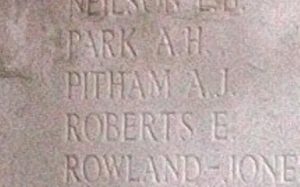
Powell, D W. This person cannot presently be identified.
Avon Emrys Gomer Price, Sergeant, 1338508, Royal Air Force Volunteer Reserve. Avon was born on 23 March 1923, the son of Mary L Price (nee Jones), of St. David’s Crescent, Brecon. He was educated together with his elder brother, John David Price, at Christ College and was in school when war broke out. As soon as he was old enough, Avon enlisted into the Royal Air Force Volunteer Reserve and after completing his training as an Air Gunner, he was posted to 196 Squadron, Royal Air Force, which was based at RAF Witchford, in Cambridgeshire. On the night of 5 September 1943, Avon took off from Witchford aboard Short Stirling III, Serial EE964, as part of a large force of 605 bombers sent to target Mannheim and Ludwigshafen. The force was well led by the Pathfinders, who marked their targets, before heading to bomb Mannheim first and then move on to Ludwigshafen. Avon was killed when his Stirling crashed at Bachenau, some seven miles north of Heilbronn during the following morning of 6 September 1943. Only one man survived and was taken prisoner. Avon was 20 years old when he was killed during the crash. He was originally buried together with his fellow crewmen in Bachenau Cemetery, but in October 1947 their graves were relocated into Durnbach War Cemetery, Germany. Avon is not commemorated on the Brecon war memorial but is commemorated at Christ College.
David Thomas Price, Ordinary Seaman, D/JX 163243, Royal Navy. David was born at Brecon on 1 September 1923, the son of L. Price. He enlisted into the Royal Navy and was posted aboard the J-class destroyer, HMS Jupiter. After completing her sea trials in September 1939, Jupiter joined the 7th Destroyer Flotilla of the Home Fleet, based on the Humber. She was later transferred to the Mediterranean. On 29 November 1941, Jupiter and HMS Encounter, both detached from the Mediterranean Fleet, joined up with Force G at Colombo, before escorting HMS Repulse to Singapore. Soon after arriving, following the Japanese invasion of Malaya, Repulse joined Force Z in attacking the Japanese invasion force. Jupiter remained docked at Singapore when Force Z set sail, so was not with Repulse when the mighty battlecruiser, together with HMS Prince of Wales, were tragically sunk by Japanese aircraft on 10 December. Following the opening of the Battle of Singapore, Jupiter left harbour and carried out escort duties before joining an ABDACOM force on 25 February. Unfortunately, whilst taking part in the Battle of the Java Sea on 27 February 1942, Jupiter struck a mine which had been laid by a Dutch minelayer and sank with the loss of 84 lives. David was 19 years old when he died that day. He has no known grave and is commemorated on the Plymouth Naval Memorial, Devon. David is not commemorated on the Brecon war memorial.
George Edward Price, Serjeant, 3906211, South Wales Borderers. George was born on 19 January 1904, the son of Charles and Mary Ann Price, of Chillianwallah, The Watton, Brecon. He followed in his father’s footsteps and enlisted into the South Wales Borderers, before being posted to the 1st Battalion, South Wales Borderers. The battalion was in India when war broke out, but in November 1941 it sailed for Iraq, to help protect the vital oilfields. In May 1942 the battalion travelled by land through the desert to Libya and took up defensive positions around Tobruk. Tobruk was soon under heavy attack and on 17 June, under intense pressure, the battalion was ordered to withdraw. George was killed on the following day, on 18 June 1942, probably as part of the rear-guard action which took place as the bulk of the battalion made its way to awaiting transport. The 38-year-old has no known grave and is commemorated on the Alamein Memorial, Egypt.
Trevor David Price, Corporal, 4077783, South Wales Borderers. Trevor was born on 1 January 1921, the son of David Lemuel Francis Price and Elsie Jane Price (nee Rosser), of 1 Cobbs Town, Llanfihangel-Talyllyn. He enlisted into the Monmouthshire Regiment, but was later transferred to the 1st Brecknockshire Battalion, South Wales Borderers. Following mobilisation, the battalion’s first deployment was at Cardiff and Newport Docks for garrison duties. The battalion moved to Liverpool briefly in about September 1940, where it was inspected by King George VI and his daughter Princess Elizabeth. In February 1941 the battalion moved to Blenheim Barracks in Aldershot, then two months later moved to Petworth Park, before moving to Chichester in June, but by the end of the year the battalion had moved again to Pondbury Barracks in Dorset. Trevor died in Dorset on 4 March 1942. The remains of the 21-year-old were brought home and he was buried in St. Michael’s Churchyard, Llanfihangel-Talyllyn.
Edgar Ronald Roberts, Corporal, 2123348, Royal Engineers. Edgar was born in Llanelli in 1917, the son of Trevor Edgar Roberts and Margaret Roberts (nee Howells). The family moved to The Manse, Brecon prior to the war. Edgar had enlisted into the Royal Engineers and was posted to 79 Assault Squadron, Royal Engineers, an armoured unit, which was equipped with a variety of modified tanks, or ‘Hobart’s Funnies’. He married Catherine Dorothy Davies whilst home on leave at Brecon in 1943. Edgar’s unit was attached to the 1st Assault Brigade, RE, which was attached to the 79th Armoured Division and had formed in March 1943. The squadron had been based in various locations including Fort George near Inverness, where it trained in the use of these modified tanks before landing on Sword Beach on D-Day. Edgar was killed during the D-Day landings, on 6 June 1944. The 26-year-old has no known grave and is commemorated on Panel 11 of the Bayeux Memorial, France.
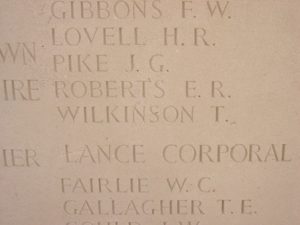
Roberts, J P. This person cannot presently be identified.
Cyril Welstead Rothero, Staff Serjeant, S/67033, Royal Army Service Corps. Cyril was born on 25 May 1907, the son of David Welstead Rothero and Florence Sybil Rothero, of Bron-y-Glyn, Brecon. He married Annie Maria Rowlands, of Newmarket in 1926. Cyril enlisted into the Royal Army Service Corps and by the time of the Normandy landings, on D-Day, had been promoted to Staff Serjeant. He would have seen action during the break-out from the Normandy beachhead and in the subsequent drive northwards into Northern France and Belgium over the coming months. Cyril died at Brussels on 21 November 1944. The 37-year-old was buried in Brussels Town Cemetery, Belgium.
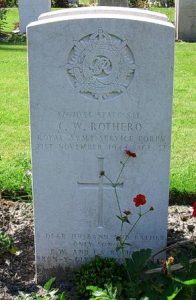
Geoffrey Douglas Rowberry, Able Seaman, C/JX154720, Royal Navy. Geoffrey was born on 1 July 1921, the son of Francis George Rowberry and Mabel Louise Rowberry (nee Hutchings), of 31, Orchard Street, Llanfaes, Brecon. He enlisted into the Royal Navy and was posted aboard the fleet repair ship, HMS Sandhurst. She had been based at Dover in 1939-1940 before becoming a depot ship for escort vessels at Londonderry, Northern Ireland and later moved to Greenock, Scotland. At some time after this move Geoffrey took ill and was invalided to Mearnskirk Hospital, at Newton Mearns near Glasgow. Sadly, he died there of tuberculosis and meningitis on 12 December 1944. The remains of the 23-year-old were brought to Coventry, where his parents had moved to just after the outbreak of war, and he was buried in St. James Churchyard, Stivichall. His brother, John James Rowberry, was killed in North Africa in 1942, whilst their brother-in-law, Percy Reginald Wynde, was killed over Germany in 1944.
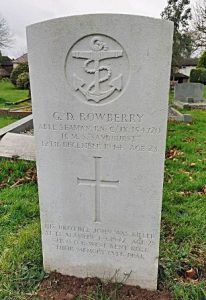
John James Rowberry, Serjeant, 6345884, Queen’s Own Royal West Kent Regiment. John was born on 29 April 1914, the son of Francis George Rowberry and Mabel Louise Rowberry (nee Hutchings), of 31, Orchard Street, Llanfaes, Brecon. He enlisted into the army and was posted to the 5th Battalion, Queen’s Own Royal West Kent Regiment, a Territorial Army unit that was attached to the 132nd Infantry Brigade, 44th (Home Counties) Division. The division had been in France with the BEF in 1940 and after being evacuated from Dunkirk spent two years on home service before embarking for North Africa in May 1942, to take part in the North African Campaign. The division saw its first major action during the Battle of Alam el Halfa, which opened on 30 August 1942, south of El Alamein. The battle opened when Rommel attempted to envelop the Eighth Army, before reinforcements could arrive to bolster Montgomery’s command. Montgomery was aware of the German ambitions, so left a gap in his line whilst reinforcing the Alam el Halfa Ridge and when the Afrika Korps attacked its tanks were met with heavy fire from the Allies and suffered terrible casualties. John was killed in action during the latter stages of the battle, on 3 September 1942. The 28-year-old is buried in El Alamein War Cemetery, Egypt. His brother, Geoffrey Douglas Rowberry, also died on service and their brother-in-law, Percy Reginald Wynde, was killed over Germany in 1944.
Muhammad Sarwar, Driver, 175697, Royal Indian Army Service Corps. Muhammad was the son of Rab Nawaz and Ghulam Fatima, of Khushab, Shahpur, India (now modern-day Pakistan). He enlisted into the Royal Indian Army Service Corps and was posted to Britain with the 25th Mule Company. Muhammad probably served in France with the BEF at the outbreak of war and would then have been evacuated from Dunkirk. He died at Brecon on 17 June 1941, aged 26, and is buried in Brecon Cemetery. He is not commemorated on the Brecon war memorial.
Ronald Clifford Scholefield, Trooper, 14339628, Royal Armoured Corps. Ronald was the son of Harold and Olive Minnie Scholefield (nee Kidman), of Brecon. After leaving Christ College he enlisted into the army and was posted to C Squadron of the Nottinghamshire Yeomanry, which was attached to the Royal Armoured Corps. The Nottinghamshire Yeomanry was converted from cavalry to an artillery regiment in 1940, taking part in the defence of both Tobruk and Benghazi as well as the battle of Crete. In 1941, the Regiment converted to armour before joining the 8th Armoured Brigade and served in most of the major battles of the Eighth Army in the North Africa campaign, including Alam El Halfa and Second El Alamein and the Tunisia Campaign. The Regiment then returned to Britain to re-equip with Sherman DD and Sherman Firefly tanks, before landing in Normandy on D-Day, being thrown into the terrible fighting against the superior armour of the German Panzer Divisions. Ronald was killed when his tank was destroyed on 2 August 1944. The 20-year-old was originally buried with his two fellow crewmen on the battlefield near Jurques, but in August 1945 their graves were exhumed, and the three men were re-interred in Bayeux War Cemetery, France. Ronald is not commemorated on the Brecon war memorial but is commemorated in Christ College.
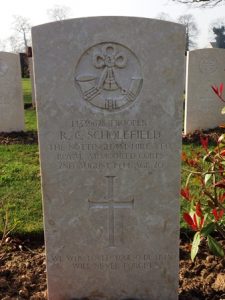
Laurence Henry Sefton, Sergeant, 1315145, Royal Air Force Volunteer Reserve. Laurence was the son of George Edward Sefton and Alice Sefton (nee Stone), of Newport, Mon. His father died in 1933 and Laurence and his mother moved to Brecon. Laurence was educated at Christ College but following the outbreak of war enlisted into the Royal Air Force Volunteer Reserve. After completing his training as a Wireless Operator/ Air Gunner, Laurence was posted to 10 Squadron, Royal Air Force, which was a night bomber unit, based at RAF Leeming, in Yorkshire, equipped with Armstrong Whitworth Whitley’s. In December 1941, the squadron converted to the Handley Page Halifax, then on 19 August 1942 relocated to RAF Melbourne, in Yorkshire. On the night of 17 August 1943, Laurence took off from Melbourne aboard Handley Page Halifax II, Serial JD200, which formed part of a large force of 596 aircraft detailed to bomb the Nazi V2 testing facility at Peenemünde. The force suffered some 40 aircraft lost during the raid, including that of Laurence’s. No trace of his Halifax was ever found, so the 21-year-old is commemorated alongside his fellow crewmen on the Runnymede Memorial, Surrey.
Muhammad Sharif, Driver, 171032, Royal Indian Army Service Corps. Muhammad was the son of Majabat Ali and Karam Begam, of Kotli, Poonch, Kashmir; and the husband of Jumaro Begam. He enlisted into the Royal Indian Army Service Corps and was posted to Britain with the 29th Mule Company. Muhammad probably served in France with the BEF at the outbreak of war and would then have been evacuated from Dunkirk. He died at Brecon on 14 August 1941, aged 28, and is buried in Brecon Cemetery. He is not commemorated on the Brecon war memorial.
Albert Charles Smith, Private, 3911175, South Wales Borderers. Albert was born on 17 July 1917, the son of Alfred Charles Smith and May Smith, of Birmingham. He married Gwyneth Muriel Williams, of Brecon, in 1941. Albert had enlisted into the army and was posted to the 1st Battalion, South Wales Borderers. The battalion was in India when war broke out, but in November 1941 it sailed for Iraq, to help protect the vital oilfields. In May 1942 the battalion travelled by land through the desert to Libya and took up defensive positions around Tobruk. Tobruk was soon under heavy attack and on 17 June, under intense pressure, the battalion was ordered to withdraw, suffering heavy losses and large numbers of men were captured by the Italians. Due to severe losses the battalion was then disbanded, but some men were sent home to form the nucleus of the 4th Battalion, Monmouthshire Regiment, before that battalion became the new 1st Battalion, South Wales Borderers in December 1942. Albert was among the men of the battalion captured and taken prisoner in North Africa. He was initially interred in Italy but following the Allied invasion of Italy in 1943 would have been moved, eventually to a POW camp in Czechoslovakia. He died in captivity on 6 November 1944. The 27-year-old is buried in Prague War Cemetery, in the modern-day Czech Republic.
Leonard Marsdon Spencer, Private, S/4079378, Royal Army Service Corps. Leonard was the son of William Spencer and Elizabeth Spencer (nee Williams), of 4, Free Street, Brecon. His father served during the Great War as a Sergeant with the South Wales Borderers. Leonard enlisted into the army soon after the outbreak of war and was posted to the Royal Army Service Corps. He married Gladys Emily Carter, of North End, Portsmouth, in 1942. He probably embarked for the Far East soon afterwards and was posted to Calcutta. He died in Calcutta on 13 October 1945, after the wars end. The 23-year-old is buried in Bhowanipore Cemetery, Calcutta, India.
William Taylor, Fusilier, 7888872, Royal Welch Fusiliers. William was born in Liverpool in 1921. He enlisted into the army and was posted to the 1st Battalion, Royal Welch Fusiliers. William married Doreen Doyle, of 7, Maendu Street, Llanfaes, Brecon, in 1942. The original battalion had been decimated during the retreat to Dunkirk in 1940 and spent almost two years on home service embarked for India with the 2nd Division to join the fight against the Japanese. William was killed in Burma soon after the battalions arrival, on 18 March 1943. The 21-year-old has no known grave and is commemorated on the Rangoon Memorial, Myanmar.
Edgar Tonge, Sergeant, 1411098, Royal Air Force Volunteer Reserve. Edgar was born at Merthyr Tydfil in 1921, the son of Sidney Tonge and Isabella Tonge (nee Pugh). The family later resided at 4, Mount Pleasant Gardens, Brecon. Edgar enlisted into the Royal Air Force Volunteer Reserve and after completing his training as a Wireless Operator/ Air Gunner was posted to 76 Squadron, Royal Air Force. The squadron had originally been equipped with Handley Page Hampden’s before re-equipping with the Handley Page Halifax at RAF Linton-on-Ouse in May 1941 as part of No. 4 Group, Bomber Command and began operations over occupied Europe. In June 1943 the squadron moved to RAF Holme-on-Spalding Moor, where it continued to operate. On the evening of 2 June 1944 Edgar took off from Holme-on-Spalding Moor aboard a Handley Page Halifax III, Serial LK783, which joined a group of some 128 aircraft despatched to attack the railway yards at Trappes, in France. Edgar was killed along with all his fellow crewmen when their Halifax crashed near Treon, France on the morning of 3 June 1944. The 22-year-old was buried with his comrades in a collective grave in Dreux Communal Cemetery, France.
Philip Henry Williams, Gunner, 965081, Royal Artillery. Philip was born on 30 June 1917, the son of John Cyril Williams and Eleanor Williams (nee Phillips), of 1, Nicolas Row, Brecon. He enlisted into the army and was posted to 52 Anti-Tank Regiment, Royal Artillery. The regiment had served in France with the 5th Infantry Division of the BEF in 1940 and after being evacuated spent almost two years on home service before embarking for India. In August 1942 the division moved to Iraq, before being transferred to Syria in February 1943. In July 1943 the division landed in Sicily and took part in the campaign to drive the Germans out of Sicily, then on 3 September took part in the invasion of mainland Italy. Philip was killed near Salerno on 1 October 1943. The 26-year-old is buried in Salerno War Cemetery, Italy.
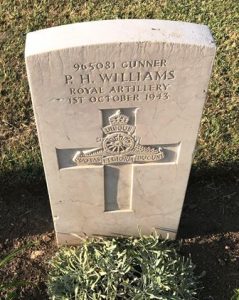
Rees Davies Williams, Flight Sergeant, 547160, Royal Air Force. Rees was born in 1919, the son of Thomas George Williams and Gertrude Williams (nee Davies), of The George Hotel, Brecon. He enlisted into the Royal Air Force and trained as a pilot before being posted to 21 Squadron, Royal Air Force. The squadron began the war operating the Bristol Blenheim IV, on reconnaissance missions. It then took part in ground attack operations as the BEF withdrew to Dunkirk in May 1940. The following month the squadron moved to RAF Lossiemouth in Scotland, where it took part in operations against German shipping off the Norwegian coast, then moved back to Norfolk to continue anti-shipping operations. The squadron then moved to Malta where it was almost decimated, so a new 21 Squadron was formed at RAF Bodney, still equipped with the Bristol Blenheim, but re-equipped a few months later with the Lockheed Ventura. On 15 October 1942, Rees took off from RAF Bodney flying a Lockheed Ventura I, Serial AE760 on an operational training fight. The aircraft crashed at Swaffham, Norfolk while making a single engine approach to RAF Bodney, killing Rees and his crew. Rees was 24 years old when he was killed that day. His body was recovered from the wreck, and he was brought home to be buried in Brecon Cemetery.
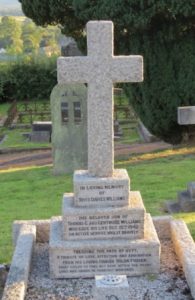
Sydney Herbert Williams, Private, 3949095, Army Catering Corps. Sydney was born in Cardiff on 22 June 1900, the son of Edwin James Williams and Sarah Jane Williams (nee Stanton). His mother was from Brecon and by 1939 Sydney was living with his wife, Helen Williams, at 36, The Struet, Brecon. He had enlisted into the Royal Army Ordnance Corps, before being transferred to the Army Catering Corps. Sydney died at Gloucester on 16 October 1944. The remains of the 45-year-old were buried in Merthyr Dyfan Burial Ground, Barry. Sydney is not commemorated on the Brecon war memorial.
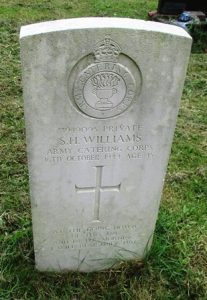
Percy Reginald Wynde, Sergeant, 967562, Royal Air Force Volunteer Reserve. Percy was born in 1906, the son of William George Wynde and Lucy Wynde (nee Hawkins), of Cardiff. He moved to Brecon as a young man with his work as an AA Road Patrol man, and on 27 March 1932 married Dorothy Mabel Rowberry. Their first daughter was born in the town, but just prior to the war the couple had moved to 75, Forrest Road, Cardiff. Percy enlisted into the Royal Air Force Volunteer Reserve and after training as a Flight Engineer was posted to 463 (Australian) Squadron, Royal Air Force. The squadron was formed in Britain in late 1943, equipped with Avro Lancaster bombers and was based at RAF Waddington, from where it carried out raids over Germany. On the evening of 24 February 1944 Percy took off from Waddington aboard an Avro Lancaster III, Serial LM444, as part of a large force of bombers sent to hit targets in Schweinfurt. Percy was killed when his Lancaster was shot down by flak over the target area on the following morning, 25 February 1944. The 37-year-old is buried in Durnbach War Cemetery, Germany. Two of his brothers-in-law, Geoffrey Douglas Rowberry and John James Rowberry, also died during the war. Percy is not commemorated on the Brecon war memorial.
